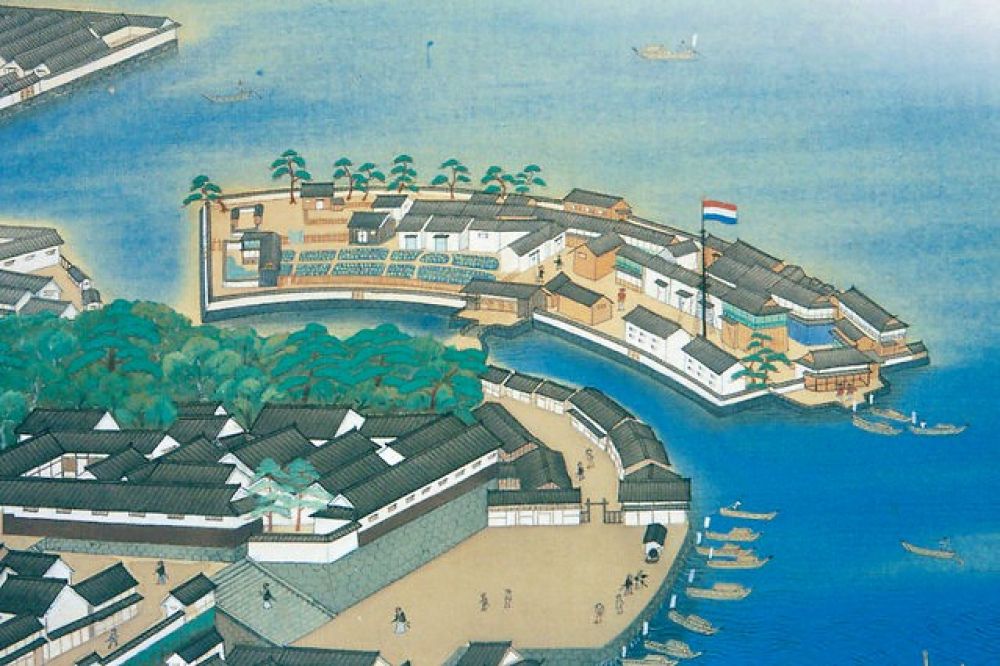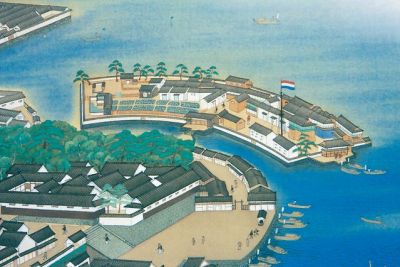

Dejima Wharf in Nagasaki is a modern commercial complex and historical site that provides visitors with a scenic waterfront experience. Formerly an artificial island constructed in the 17th century to segregate Portuguese residents from the Japanese population, it played a significant role during the isolation period of Japan when it served as the sole gateway for foreign trade and cultural exchange. Today, the wharf area is known for its charming atmosphere, sea breezes, and range of dining options, offering both Japanese and international cuisine. Visitors can enjoy shopping at boutique stores, strolling along the promenade, or sitting back to admire the view of the harbor, especially beautiful at sunset. The revitalization of this area has made it a perfect spot for a relaxing day out, combining history with modern comforts.
The Dejima Museum, devoted to the history of the former Dutch trading post, is a fascinating must-see in Nagasaki. It represents a significant chapter in Japan's interaction with the Western world. At this museum, you can delve into the rich past and see how Dejima functioned as Japan's sole point of contact with Europe during the period of national seclusion. The museum showcases a recreation of Dutch buildings with period-appropriate furnishings and artifacts, providing visitors with a tangible link to the 17th and 18th centuries. The knowledgeable guides offer enlightening information on the lives of the Dutch traders, their impact on Japanese culture, and the exchange of knowledge and goods that took place. Dejima Museum offers a window into the complexities of cultural exchange and the development of international relationships.
Nagasaki Kunchi is the city's most famous festival and has been celebrated for nearly 400 years, showcasing Nagasaki's multicultural history. The festival takes place annually on October 7th-9th and is based around the Suwa Shrine, although festivities happen throughout the city. Visitors are mesmerized by the vibrant dance performances, known as 'Dragons Dance,' traditional floats, and the mix of Dutch, Chinese, and Japanese cultural influences, reflective of Nagasaki's unique heritage. The ambiance of the festival is contagious with live music, street food, and colorful processions. Attending Nagasaki Kunchi provides a chance to witness a living tradition that has been designated an Important Intangible Folk Cultural Property and is a dynamic cultural exposure that should not be missed.
Shitsu Church is a picturesque Roman Catholic church located in the former island of Dejima, Nagasaki. The church has a captivating history linked to the Hidden Christians of Japan, known as 'Kakure Kirishitan,' who practiced their faith in secret during the period of Christian prohibition. This stunning church, built in a semi-Gothic and semi-Romanesque style, stands as a testament to the resilience of the Hidden Christians who returned to the Church after the ban on Christianity was lifted in the 19th century. Visiting the Shitsu Church is not only an opportunity for spiritual reflection but also a chance to understand an important piece of Nagasaki's history and the remarkable stories of faith and survival. The church's backdrop, in a serene setting with ocean views, adds to the reflective experience of the visit.
Meganebashi, known as Spectacles Bridge, is one of the most picturesque spots in Nagasaki and an iconic example of the city's historical landscape. Built in 1634, it is the oldest stone arch bridge in Japan and is named for its reflection in the water, which resembles a pair of spectacles. A stroll along the Nakashima River offers a peaceful escape from the city's hustle and bustle, inviting visitors to enjoy the passing scenes of daily life, traditional buildings, and other historical stone bridges that line the riverbanks. This walk will lead you through Nagasaki's rich history and provide ample opportunities for memorable photos. While the bridge itself is a quick stop, visitors often extend the visit walking alongside the river for a more in-depth exploration of the city's past.
The Nagasaki Atomic Bomb Museum is a somber yet essential institution that chronicles the tragic bombing of Nagasaki on August 9, 1945. The museum provides a comprehensive narrative of the events leading up to the bombing, the devastating impact on the city, and the aftermath of the explosion. With a powerful collection of photographs, artifacts, and personal memorabilia of the bombing's victims, the museum is an emotive and moving tribute to those who lost their lives. The testimonies of survivors and the replicas of the damaged cityscape immerse visitors in the horror of nuclear warfare, while also promoting a message of peace and the necessity of nuclear disarmament. A visit here is a profound experience, highlighting the resilience of Nagasaki's citizens and the city's commitment to peace.
The Nagasaki Peace Park and the Hypocenter Park are two interlinked sites dedicated to the memory of the atomic bombing victims and serve as a universal message of peace. The Peace Park features the iconic 'Peace Statue,' symbolizing the city's wish for tranquility. Surrounding the statue is a park filled with artwork from different countries, each conveying their support for peace and solidarity with Nagasaki. Meanwhile, a short walk takes you to the Nagasaki Hypocenter Park, which marks the exact explosion site of the atomic bomb. A black pillar and a simple, poignant museum is available to further explain the events of that fateful day. These contemplative spaces not only honor the past and those who suffered but also advocate for a future without nuclear weapons.
Glover Garden is an open-air museum in Nagasaki that serves as a window into the lifestyle of foreign merchants during the Meiji Period. The garden contains restored mansions including the former residence of Thomas Blake Glover, a Scottish merchant pivotal in the modernization of Japan. Visitors can admire the blend of Western and Japanese architectural elements and enjoy stunning views of Nagasaki harbor from the hillside. The lush gardens are beautifully manicured, providing a tranquil setting to explore the various historical buildings. Each house within Glover Garden has its own story, allowing guests to learn about the influence of foreign residents and their role in the city's history. The experience is both picturesque and educational, offering a glimpse of a unique period in Japanese history.
Oura Church, officially known as the Basilica of the Twenty-Six Holy Martyrs of Japan, stands as the country's oldest wooden Christian church dating back to 1864. Recognized as a National Treasure, the church was erected in honor of the 26 Catholic martyrs who were executed in the 16th century for their beliefs, signaling the once forbidden Christian practice in Japan. The Gothic-style design stands out from its surroundings, and its picturesque setting on a hillside provides an impressive backdrop for visitors. The interior of the church contains artifacts connected to the Hidden Christians and offers a serene atmosphere for reflection. The church's historical significance is not only religious but also serves as a monument to Japan's complex history of international relations and cultural shifts.
Nagasaki Seaside Park is a coastal oasis offering respite from city life and a chance to partake in Japanese cultural activities. With expansive lawns, seasonal flowers, and art installations, the park provides a picturesque setting for relaxation and recreation. Visitors can rent a kimono to immerse themselves fully in Japanese culture while exploring the park's beauty. Traditional tea ceremonies and ikebana (flower arranging) classes are offered occasionally, giving travelers a hands-on opportunity to delve deeper into the subtleties of Japanese traditions. The park also organizes events, such as musical performances and cultural festivals, which are vibrant displays of local customs and talents. Whether it's joining a festival, trying out cultural arts, or simply lounging amidst natural beauty, the park offers a reinvigorating break and cultural enrichment.
